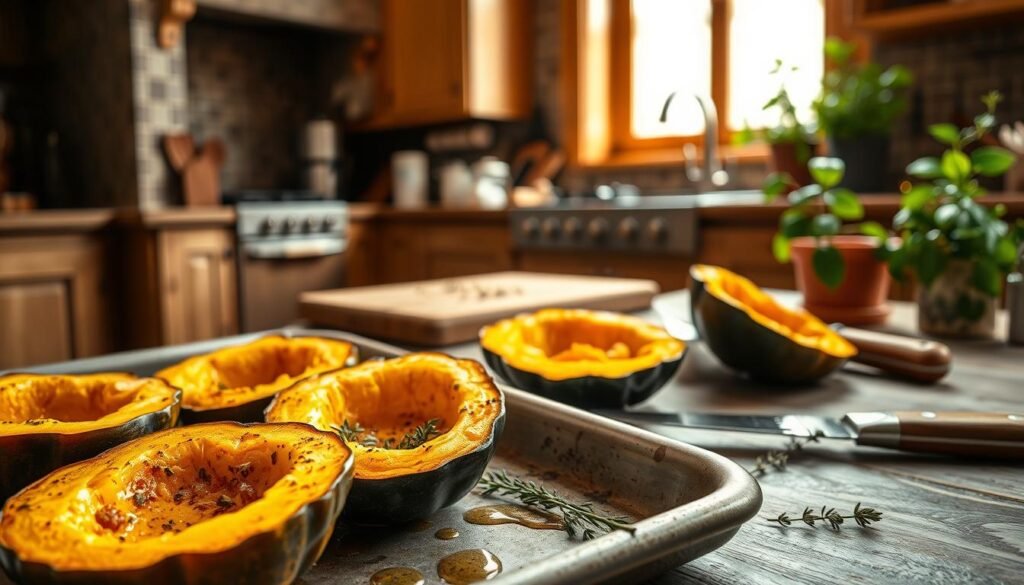Did you know acorn squash has more potassium than a banana? This fun fact introduces us to the amazing world of this healthy veggie. Whether you’re a pro in the kitchen or just starting out, learning to cook acorn squash can make your fall and winter meals better. In this guide, I’ll show you how to cook acorn squash in tasty ways, like roasting and grilling. It’s going to be a fun journey into the world of acorn squash recipes!
Key Takeaways
- Acorn squash is rich in potassium and other essential nutrients.
- There are multiple methods for preparing acorn squash, including roasting, baking, boiling, steaming, and grilling.
- Utilizing seasonal recipes can enhance your culinary experience with acorn squash.
- Proper selection and preparation are key to enjoying the sweetness of acorn squash.
- Experimenting with different flavor profiles can bring out the best in your dishes.
- Leftover acorn squash can be creatively used in soups, stews, and desserts.
Understanding Acorn Squash: Key Features and Benefits
Acorn squash is not just pretty with its unique shape and color. It also packs a lot of nutritional benefits. This makes it a great choice for anyone wanting to eat healthier.
Nutritional Profile of Acorn Squash
Acorn squash nutrition is impressive. A serving has about 189 calories, 6 grams of fat, 36 grams of carbs, and 2 grams of protein. It’s also full of Vitamin C and potassium, offering up to 26% and 16% of daily values, respectively.
How Acorn Squash Fits Into a Healthy Diet
Adding acorn squash to my meals brings variety and important nutrients. It’s low in calories but high in vitamins and minerals. This helps with weight management and overall health. Plus, its antioxidants help lower the risk of chronic diseases, making it a key part of a healthy diet.Click here to learn about how-to-cook-filet-mignon.
Choosing the Right Acorn Squash

When picking acorn squash, I look for a few important things. A firm skin without any soft spots or blemishes means it’s fresh. The squash should also feel heavy for its size, which shows it’s ripe. Squash with darker colors usually tastes sweeter and more flavorful, which I love.
Tips for Selecting Fresh Squash
Here are some tips for choosing fresh acorn squash:
- Choose squash with a hard, blemish-free skin.
- Opt for heavier squash, as this often denotes ripeness.
- Look for deep green or golden hues for better sweetness and flavor.
Understanding Different Varieties
There are many types of acorn squash out there. The most common are green and golden. Green squash is denser and sweeter, making it great in many recipes. Golden squash, on the other hand, has a milder taste that works well in some dishes. Knowing about these varieties helps me pick the best squash and try new recipes.Click here to learn about how-long-to-cook-chicken-breast-in-air-fryer.
Preparing Acorn Squash for Cooking

Getting the basics right is key when preparing acorn squash. First, I wash the squash under cool running water to remove dirt. Then, I pat it dry to make cutting easier.
Washing and Cutting Techniques
To cut acorn squash, I use a sharp knife. I slice it in half vertically from stem to tip. If it’s tough, I pierce it and microwave for a minute or two to soften it.
Once cut, I scoop out the seeds and stringy pulp. This step is important for texture and preparation.
Seeds and Pulp: What to Do With Them
After removing the seeds, I wash and dry them for roasting. They make a crunchy snack that goes well with many flavors. The cooking squash pulp, I blend into soups or purées.
Roasting Acorn Squash: A Simple and Delicious Method

Roasting acorn squash brings out its natural sweetness. It makes the squash tender and versatile. You can use it as a side dish or a main course. The steps are easy and can be tailored to your taste.
Step-by-Step Roasting Instructions
- Preheat your oven to 425°F.
- Cut the acorn squash in half and scoop out the seeds.
- Coat the insides with olive oil, salt, and a touch of maple syrup for added sweetness.
- Place the halves cut side up on a parchment-lined baking sheet.
- Roast for 25 to 40 minutes, depending on size, until the squash is tender and golden.
Flavor Variations to Try
There are many ways to flavor acorn squash. I enjoy trying different herbs and spices:
- Fresh herbs like sage or rosemary add a delicious aromatic touch.
- Spices such as cinnamon and nutmeg offer warmth and depth.
- For a savory twist, consider topping with grated Parmesan cheese or a drizzle of apple cider vinegar dressing.
Baking Acorn Squash: Sweet and Savory Options

Baking acorn squash brings out its natural sweetness and creates a delightful texture. I’ve learned effective baking methods that make it easy to add this nutritious vegetable to my meals. I enjoy experimenting with different seasonings and fillings to enhance its flavor.Click here to learn about how-to-cook-ribs-in-the-oven.
Basic Baking Techniques
To bake acorn squash, I preheat my oven to 350°F. I halve the squash and place it cut-side down in a baking pan. This allows it to steam gently.
After about 30 minutes, I turn it cut-side up. Then, I season it generously and sometimes add butter and brown sugar for extra flavor. This method makes it sweeter and cooks it evenly.
After returning it to the oven for an additional 20 minutes or until fully tender, the result is always satisfying.
Stuffing Ideas for a Complete Meal
Stuffed acorn squash is one of my favorite meal ideas, offering both flavor and nutrition. I fill the squash with a mix of grains like quinoa or wild rice and sautéed vegetables. To add depth and interest, I include nuts, dried fruits, and a variety of spices.
The finished product serves as a hearty main dish, perfect for impressing family and friends while still being simple to prepare.
Boiling and Steaming Acorn Squash

When it comes to cooking acorn squash, people often debate boiling vs. steaming. Both methods have their own advantages, offering different textures and tastes. They are both quick and keep the squash’s nutrients, making it a healthy choice.
Benefits of Boiling vs. Steaming
Boiling makes acorn squash soft and tender, perfect for soups or purees. Steaming, on the other hand, keeps more flavor and a firmer texture. It’s great for those who like a bit of crunch in their squash.
How to Boil or Steam Properly
To boil acorn squash, chop it into cubes and cook in salted water. It cooks in 10 to 15 minutes until tender. For steaming, cut the squash into pieces, place in a steamer basket, and steam for 12 to 15 minutes. This way, you get flavorful squash that goes well with many dishes.
For more ways to cook acorn squash, check out this resource. It offers a variety of cooking techniques.
Grilling Acorn Squash for a Smoky Flavor

Grilling acorn squash brings out its natural sweetness and adds a smoky flavor. It’s perfect for outdoor gatherings, where the grilled squash’s vibrant taste is a hit. To get perfectly grilled slices, proper preparation is key.Click here to learn about how-to-cook-tofu.
Preparation Steps for Grilling
I start by slicing the acorn squash into half-inch thick rounds after removing the seeds. This size ensures even cooking and helps achieve those coveted grill marks. I brush each slice with olive oil and season them with salt and pepper.
Preheating the grill is crucial; I set it to medium-high heat. Then, I place the slices on the grill for about 5-7 minutes on each side. The goal is to achieve tenderness and let the flavors develop beautifully.
Best Marinades and Seasonings
For marinades, a mix of balsamic vinegar, minced garlic, and honey works great. This blend complements the squash’s flavor perfectly. For those who like spice, adding grilling seasonings like cumin and paprika is exciting.
Fresh herbs can also enhance the taste, making outdoor cooking with acorn squash even more enjoyable. For more recipes and methods, check out this guide on grilling acorn squash.
Acorn Squash Recipes to Satisfy Any Palate
Acorn squash is great for both sweet and savory dishes. It’s a versatile ingredient for any meal. In my kitchen, I enjoy trying out sweet acorn squash recipes and savory acorn squash recipes. It’s perfect for cozy desserts or hearty main dishes.
Sweet Acorn Squash Specials
If you love sweet treats, acorn squash is a hit. I bake it with maple syrup and cinnamon to highlight its sweetness. The result is a delicious, yet healthy, dessert.
One of my top picks is baked acorn squash with honey. It’s served with vanilla ice cream for a cozy dessert.
Savory Dishes Featuring Acorn Squash
Savory dishes with acorn squash are just as exciting. I often make stuffed acorn squash with Italian sausage and veggies. It’s a great main dish for any gathering.
Other main dish ideas include creamy acorn squash bisque. It’s perfect for warming up on chilly days. These recipes show how versatile acorn squash is, from comforting sides to tasty entrees.
| Recipe Type | Key Ingredients | Serving Suggestions |
|---|---|---|
| Sweet | Maple syrup, cinnamon, honey | With ice cream or as a standalone dessert |
| Savory | Italian sausage, vegetables, spices | As a hearty main dish |
| Soups | Onion, garlic, cream | With crusty bread for dipping |
Storing and Reheating Cooked Acorn Squash
After cooking delicious acorn squash, it’s important to store and reheat it right. This keeps its flavor and texture perfect. Here are some tips to keep your squash fresh and tasty for later.
Best Practices for Storage
For storing acorn squash, use an airtight container in the fridge. This stops moisture loss and keeps the squash yummy. Leftovers stay good for up to four days.
If you want to keep it longer, freeze it in freezer-safe bags. Make sure to remove air to avoid freezer burn.
Reheating Tips for Optimal Flavor
To reheat acorn squash, the oven is best for even heat. Preheat to 350°F and warm for 15 minutes. Or, use the microwave for a quicker option.
My reheating tips include adding butter or seasoning. This makes the squash taste like it’s just cooked. By following these tips, you can enjoy acorn squash as much on day four as on the first day.
Creative Ways to Use Leftover Acorn Squash
After enjoying a delicious meal with acorn squash, I often have leftovers. I love getting creative with them. One of my favorite ways is to blend leftover acorn squash into soups.
The creamy texture of acorn squash makes any broth richer, perfect for autumn stews. Its sweet and nutty flavor goes well with spices and root vegetables. This makes for a comforting dish.
I also enjoy trying acorn squash in desserts. Mashing it and adding it to pies or muffins adds moisture and a unique taste. These creative uses for squash make traditional recipes better. They let me enjoy seasonal ingredients in new ways.
If you’re curious about more ways to use acorn squash, check out some delicious ideas at this link. It inspires culinary creativity.





















